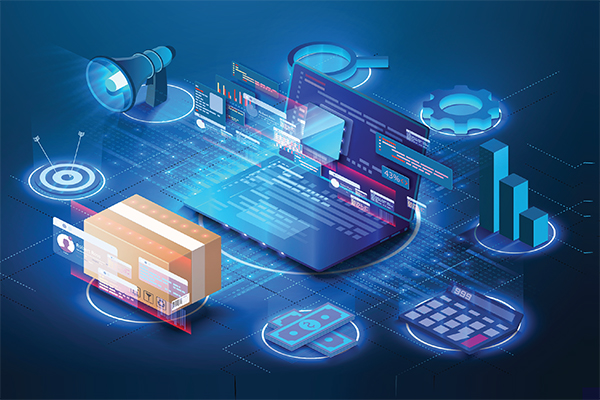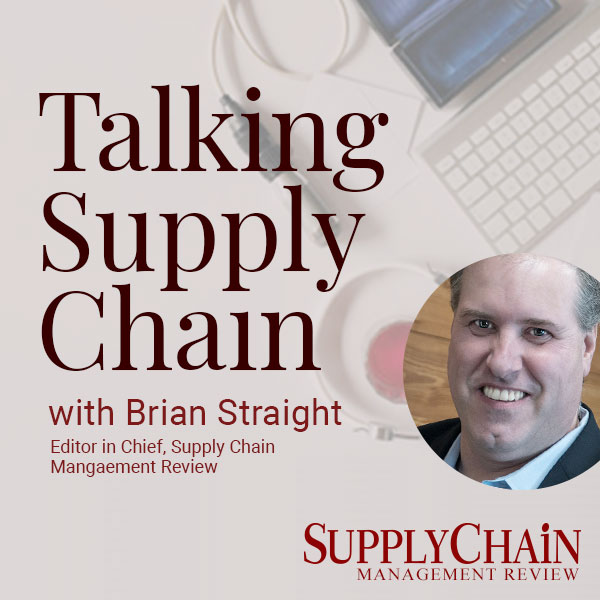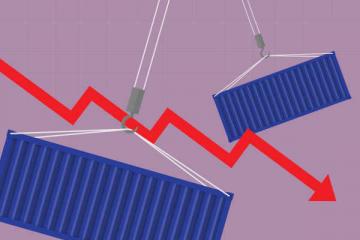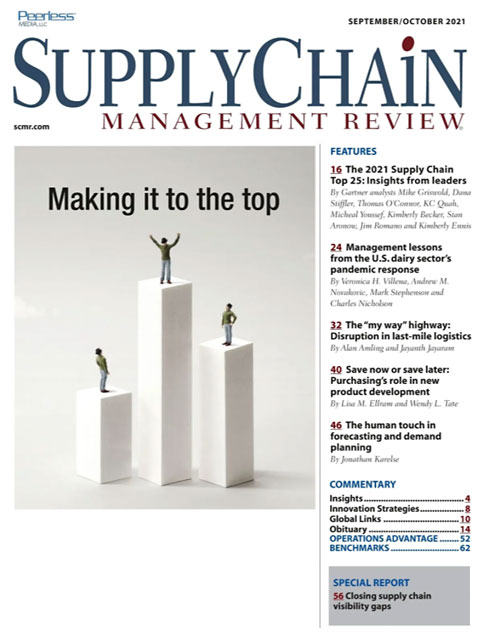Sorry, but your login has failed. Please recheck your login information and resubmit. If your subscription has expired, renew here.
September-October 2021
This time every year, we publish Gartner’s Top 25 supply chains, the annual list of the supply chains that have made it to the top, a list that now also includes 5 Masters, or companies that have consistently outperformed year after year. You can read the article in this issue, along with the web exclusive material we publish on scmr.com, to find out what it takes to become a supply chain leader. Browse this issue archive.Need Help? Contact customer service 847-559-7581 More options
Whether it’s detecting unusual or sudden spikes in demand, automating the ordering process, ensuring effective stock utilization or making warehouses more efficient, software has been playing an important role in supply chain management for decades. As they became more global and complex, the world’s supply chains are demanding more advanced applications to run on.
Technology vendors are responding by tweaking existing solutions and introducing new software platforms designed to meet those needs. The introduction of Cloud computing—a supply chain management (SCM) sector that’s growing by 14.3% a year and expected to reach $7.03 billion by 2023—has made software solutions accessible to a broader swath of companies. This effectively democratized applications used to manage transportation (TMS), warehousing (WMS), global trade (GTM) and procurement, among other functions.
In recent years, these applications evolved along with user needs and began tackling bigger challenges, shielding against new risks and offering new ways to improve efficiencies. When the global COVID-19 pandemic emerged in 2020, taking many of the world’s supply chains down along with it, companies turned to software to get their networks back up and running.
With container shortages, port congestion, labor shortages and other disruptions continuing to affect organizations in 2021, companies are thinking more deeply about how they can fix or replace their underlying legacy processes to make longer-lasting changes to their supply chain technology stacks.
And instead of using software to patch holes in their networks, organizations are putting more time, effort and money into digital business acceleration, overall supply chain modernization and end-to-end visibility. The latter was an especially sore pain point for companies that lacked such capabilities going into the pandemic.
Trevor Miles, a thought leader with Belgium-based supply chain consultancy Bluecrux, says companies that were managing demand planning, distribution, warehousing, transportation and purchasing in separate silos found themselves in trouble last year. “This isn’t just a supply chain problem. We’ve grown by building silos across nearly all functions,” says Miles.
When you add outside suppliers and business partners to that list, the number of disparate systems that can’t talk to one another gets even longer. “This creates a need for a [software] layer that can stitch everything together,” Miles adds, “and a system that can eradicate the silos, analyze at scale and connect across the network.”
Companies investing in these systems should think beyond their current challenges and realize that there’s always going to be some level of variability within supply chain networks. As we know, it doesn’t take a global pandemic to turn a supply chain on end.
“Companies need constant feedback loops that show how they’re doing, how well they’re executing against their plans, what changes are taking place within those networks and which of those changes need to be addressed,” says Miles, who sees software as an important tool for helping supply chain organizations get those questions answered. “It’s about keeping a finger on the pulse and understanding where the real issues are popping up because the longer you let an issue [fester], the bigger it becomes.”
Getting the goods on time
Like Miles, Michael Ciancio, Infor’s director of go-to market strategy and execution supply chain, says visibility is top of mind for supply chain managers right now. Acknowledging that this isn’t a new trend, Ciancio says being able to track goods and materials in real-time and at any point in the supply chain has become table stakes for companies across most industries. End customers are somewhat responsible for this, namely because so many have come to expect an Amazon-esque experience when it comes to placing orders, tracking those deliveries and getting them on time.
Ciancio says companies are also leaning on their supply chain software to serve as their crystal ball, helping them predict the future. Applications that can detect and anticipate problems in the network, for example, help companies be more proactive about resolving issues before they turn into major problems. When they can meet customer demand without overstocking, for example, companies can minimize costs, use more versatile procurement cycles and seek out alternate sources of supply.
These aren’t new revelations, but they did rise to the surface in 2020. “The pandemic exacerbated the need to be more proactive versus reactive,” says Ciancio, “both from a supplier and a supply management perspective.” He says companies are also focused on security and compliance, both of which have become key concerns as supply chains have become more digitalized and connected. “Companies need full visibility into their operations from an IT perspective, such as where the software is deployed and how it’s being used,” he adds.
Better agility and good collaboration
Companies expect a lot from their supply chain software, and the vendors behind those systems take their customers’ wants and needs pretty seriously. Richard Howells, SAP’s vice president of solution management, digital supply chain, says most are looking for solutions that help improve agility, enhance visibility, support good collaboration and drive sustainability from design to decommission.
Culling his list, Howells says companies really want to reduce risk and increase resiliency, the latter of which is defined as the ability to recover quickly from difficulties (“toughness”). “The pandemic exposed global supply chains that were [built] to reduce costs,” he explains. “As a result, they also increased supply chain risk. We’ve had supply chain disruptions for years, but the pandemic brought all of the disruptions you could think of all at once.”
To work through these roadblocks and also set their operations up for future success, organizations are deploying systems that help enhance visibility both in and out of their four walls and that enable collaboration with suppliers, contract manufacturers and logistics providers. In response, software developers have introduced applications that help companies be more responsive from both a planning and logistics perspective, and that synchronize those two important links in the supply chain.
“I always say that we plan in the perfect world, but we execute in the real world,” Howells points out. “Things happen in the real world.” When the pandemic hit, for example, some SAP customers switched from monthly to weekly or even daily planning cycles. Another buckled down and prepared itself for a dry sales spell, but wound up dealing with higher demand than usual for its home improvement products. “These companies had to quickly change their planning processes to meet the ‘new’ demand,” says Howells.
“Companies need to be able to plan and re-plan at faster clock speed and using shorter planning cycles,” he continues. “They also need data to be able to make those decisions in the moment, plus the ability to share information with suppliers, logistics providers and customers.”
This aligns directly with visibility, a common thread across all the interviews conducted for this article. In fact, Howells says that the direct connection between improved visibility and better decision making—and the fact that software makes the connections needed to create higher visibility levels—may wind up being a core driver of new software investment in 2021.
“Companies with high levels of supply chain visibility are better informed and in a better position to take action; one organization’s risk is another company’s opportunity,” Howells explains. “Once a firm has the data and software in place to be able to take action based on that data, it can more effectively respond to change.” These capabilities spill over into the sustainability realm, which roughly 82% of supply chain executives are making a core part of their mission statements or purposes, according to a 2021 SAP-Oxford Economics study.
“A lot of companies want to be carbon neutral by a certain date, but do they have the right systems and business processes in place to achieve that? That’s the real question,” says Howells, who feels that supply chains will be called upon to manage a significant chunk of those reductions and/or improvements. “Having the tools in place to take action and then track and measure sustainability across the supply chain will be key,” he says.
Assessing the impacts
As they address current roadblocks and plan for the future, supply chain managers will be assessing their existing software stacks and either adding to them or replacing them with more modern, connected solutions.
Whatever strategy makes the most sense, the underlying goal will likely be four-pronged: improving supply chain visibility and resiliency while also lowering risk and operating more sustainably. Getting there will require good access to data, the elimination of departmental silos and better connections with suppliers, logistics providers and customers.
Fortunately, supply chain software is evolving right along with these needs and encompasses everything from point solutions that target a specific activity, such as transportation, warehousing or yard management, to fully-integrated systems that address all aspects of the supply chain. And while the pandemic remains top-of-mind for many companies right now, Miles advises organizations to think beyond this singular disruption.
“COVID-19 has been a major disruption, but most companies suffer smaller disruptions within their supply chains on a day-to-day basis,” Miles concludes. “The key lies in incorporating variability and analysis to identify and understand those events and how they affect supply chain performance and end customers.”
SC
MR
Sorry, but your login has failed. Please recheck your login information and resubmit. If your subscription has expired, renew here.
September-October 2021
This time every year, we publish Gartner’s Top 25 supply chains, the annual list of the supply chains that have made it to the top, a list that now also includes 5 Masters, or companies that have consistently… Browse this issue archive. Access your online digital edition. Download a PDF file of the September-October 2021 issue.Whether it’s detecting unusual or sudden spikes in demand, automating the ordering process, ensuring effective stock utilization or making warehouses more efficient, software has been playing an important role in supply chain management for decades. As they became more global and complex, the world’s supply chains are demanding more advanced applications to run on.
Technology vendors are responding by tweaking existing solutions and introducing new software platforms designed to meet those needs. The introduction of Cloud computing—a supply chain management (SCM) sector that’s growing by 14.3% a year and expected to reach $7.03 billion by 2023—has made software solutions accessible to a broader swath of companies. This effectively democratized applications used to manage transportation (TMS), warehousing (WMS), global trade (GTM) and procurement, among other functions.
In recent years, these applications evolved along with user needs and began tackling bigger challenges, shielding against new risks and offering new ways to improve efficiencies. When the global COVID-19 pandemic emerged in 2020, taking many of the world’s supply chains down along with it, companies turned to software to get their networks back up and running.
With container shortages, port congestion, labor shortages and other disruptions continuing to affect organizations in 2021, companies are thinking more deeply about how they can fix or replace their underlying legacy processes to make longer-lasting changes to their supply chain technology stacks.
And instead of using software to patch holes in their networks, organizations are putting more time, effort and money into digital business acceleration, overall supply chain modernization and end-to-end visibility. The latter was an especially sore pain point for companies that lacked such capabilities going into the pandemic.
Trevor Miles, a thought leader with Belgium-based supply chain consultancy Bluecrux, says companies that were managing demand planning, distribution, warehousing, transportation and purchasing in separate silos found themselves in trouble last year. “This isn’t just a supply chain problem. We’ve grown by building silos across nearly all functions,” says Miles.
When you add outside suppliers and business partners to that list, the number of disparate systems that can’t talk to one another gets even longer. “This creates a need for a [software] layer that can stitch everything together,” Miles adds, “and a system that can eradicate the silos, analyze at scale and connect across the network.”
Companies investing in these systems should think beyond their current challenges and realize that there’s always going to be some level of variability within supply chain networks. As we know, it doesn’t take a global pandemic to turn a supply chain on end.
“Companies need constant feedback loops that show how they’re doing, how well they’re executing against their plans, what changes are taking place within those networks and which of those changes need to be addressed,” says Miles, who sees software as an important tool for helping supply chain organizations get those questions answered. “It’s about keeping a finger on the pulse and understanding where the real issues are popping up because the longer you let an issue [fester], the bigger it becomes.”
Getting the goods on time
Like Miles, Michael Ciancio, Infor’s director of go-to market strategy and execution supply chain, says visibility is top of mind for supply chain managers right now. Acknowledging that this isn’t a new trend, Ciancio says being able to track goods and materials in real-time and at any point in the supply chain has become table stakes for companies across most industries. End customers are somewhat responsible for this, namely because so many have come to expect an Amazon-esque experience when it comes to placing orders, tracking those deliveries and getting them on time.
Ciancio says companies are also leaning on their supply chain software to serve as their crystal ball, helping them predict the future. Applications that can detect and anticipate problems in the network, for example, help companies be more proactive about resolving issues before they turn into major problems. When they can meet customer demand without overstocking, for example, companies can minimize costs, use more versatile procurement cycles and seek out alternate sources of supply.
These aren’t new revelations, but they did rise to the surface in 2020. “The pandemic exacerbated the need to be more proactive versus reactive,” says Ciancio, “both from a supplier and a supply management perspective.” He says companies are also focused on security and compliance, both of which have become key concerns as supply chains have become more digitalized and connected. “Companies need full visibility into their operations from an IT perspective, such as where the software is deployed and how it’s being used,” he adds.
Better agility and good collaboration
Companies expect a lot from their supply chain software, and the vendors behind those systems take their customers’ wants and needs pretty seriously. Richard Howells, SAP’s vice president of solution management, digital supply chain, says most are looking for solutions that help improve agility, enhance visibility, support good collaboration and drive sustainability from design to decommission.
Culling his list, Howells says companies really want to reduce risk and increase resiliency, the latter of which is defined as the ability to recover quickly from difficulties (“toughness”). “The pandemic exposed global supply chains that were [built] to reduce costs,” he explains. “As a result, they also increased supply chain risk. We’ve had supply chain disruptions for years, but the pandemic brought all of the disruptions you could think of all at once.”
To work through these roadblocks and also set their operations up for future success, organizations are deploying systems that help enhance visibility both in and out of their four walls and that enable collaboration with suppliers, contract manufacturers and logistics providers. In response, software developers have introduced applications that help companies be more responsive from both a planning and logistics perspective, and that synchronize those two important links in the supply chain.
“I always say that we plan in the perfect world, but we execute in the real world,” Howells points out. “Things happen in the real world.” When the pandemic hit, for example, some SAP customers switched from monthly to weekly or even daily planning cycles. Another buckled down and prepared itself for a dry sales spell, but wound up dealing with higher demand than usual for its home improvement products. “These companies had to quickly change their planning processes to meet the ‘new’ demand,” says Howells.
“Companies need to be able to plan and re-plan at faster clock speed and using shorter planning cycles,” he continues. “They also need data to be able to make those decisions in the moment, plus the ability to share information with suppliers, logistics providers and customers.”
This aligns directly with visibility, a common thread across all the interviews conducted for this article. In fact, Howells says that the direct connection between improved visibility and better decision making—and the fact that software makes the connections needed to create higher visibility levels—may wind up being a core driver of new software investment in 2021.
“Companies with high levels of supply chain visibility are better informed and in a better position to take action; one organization’s risk is another company’s opportunity,” Howells explains. “Once a firm has the data and software in place to be able to take action based on that data, it can more effectively respond to change.” These capabilities spill over into the sustainability realm, which roughly 82% of supply chain executives are making a core part of their mission statements or purposes, according to a 2021 SAP-Oxford Economics study.
“A lot of companies want to be carbon neutral by a certain date, but do they have the right systems and business processes in place to achieve that? That’s the real question,” says Howells, who feels that supply chains will be called upon to manage a significant chunk of those reductions and/or improvements. “Having the tools in place to take action and then track and measure sustainability across the supply chain will be key,” he says.
Assessing the impacts
As they address current roadblocks and plan for the future, supply chain managers will be assessing their existing software stacks and either adding to them or replacing them with more modern, connected solutions.
Whatever strategy makes the most sense, the underlying goal will likely be four-pronged: improving supply chain visibility and resiliency while also lowering risk and operating more sustainably. Getting there will require good access to data, the elimination of departmental silos and better connections with suppliers, logistics providers and customers.
Fortunately, supply chain software is evolving right along with these needs and encompasses everything from point solutions that target a specific activity, such as transportation, warehousing or yard management, to fully-integrated systems that address all aspects of the supply chain. And while the pandemic remains top-of-mind for many companies right now, Miles advises organizations to think beyond this singular disruption.
“COVID-19 has been a major disruption, but most companies suffer smaller disruptions within their supply chains on a day-to-day basis,” Miles concludes. “The key lies in incorporating variability and analysis to identify and understand those events and how they affect supply chain performance and end customers.”
SC
MR


Latest Supply Chain News
- Few executives believe their supply chains can respond quickly to disruptions
- Technology’s role in mending supply chain fragility after recent disruptions
- Tech investments bring revenue increases, survey finds
- Survey reveals strategies for addressing supply chain, logistics labor shortages
- Israel, Ukraine aid package to increase pressure on aerospace and defense supply chains
- More News
Latest Podcast

 Explore
Explore
Software & Technology News
- Technology’s role in mending supply chain fragility after recent disruptions
- Tech investments bring revenue increases, survey finds
- Survey reveals strategies for addressing supply chain, logistics labor shortages
- AI, virtual reality is bringing experiential learning into the modern age
- Humanoid robots’ place in an intralogistics smart robot strategy
- Tips for CIOs to overcome technology talent acquisition troubles
- More Software & Technology
Latest Software & Technology Resources

Subscribe

Supply Chain Management Review delivers the best industry content.

Editors’ Picks





